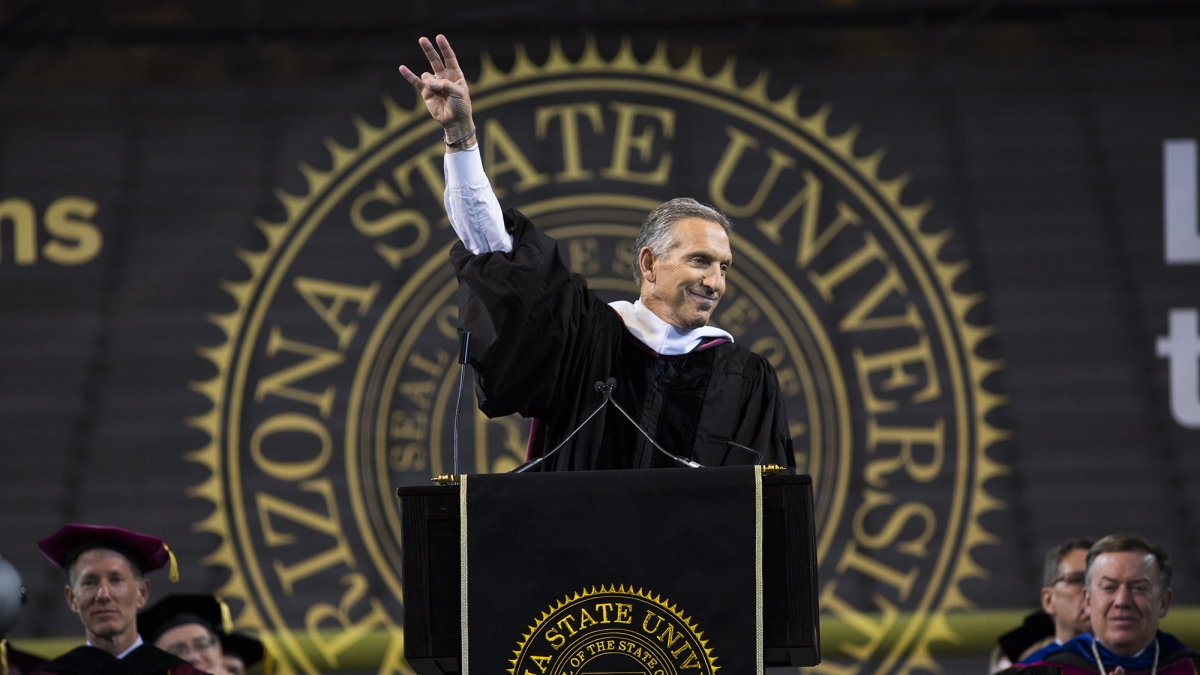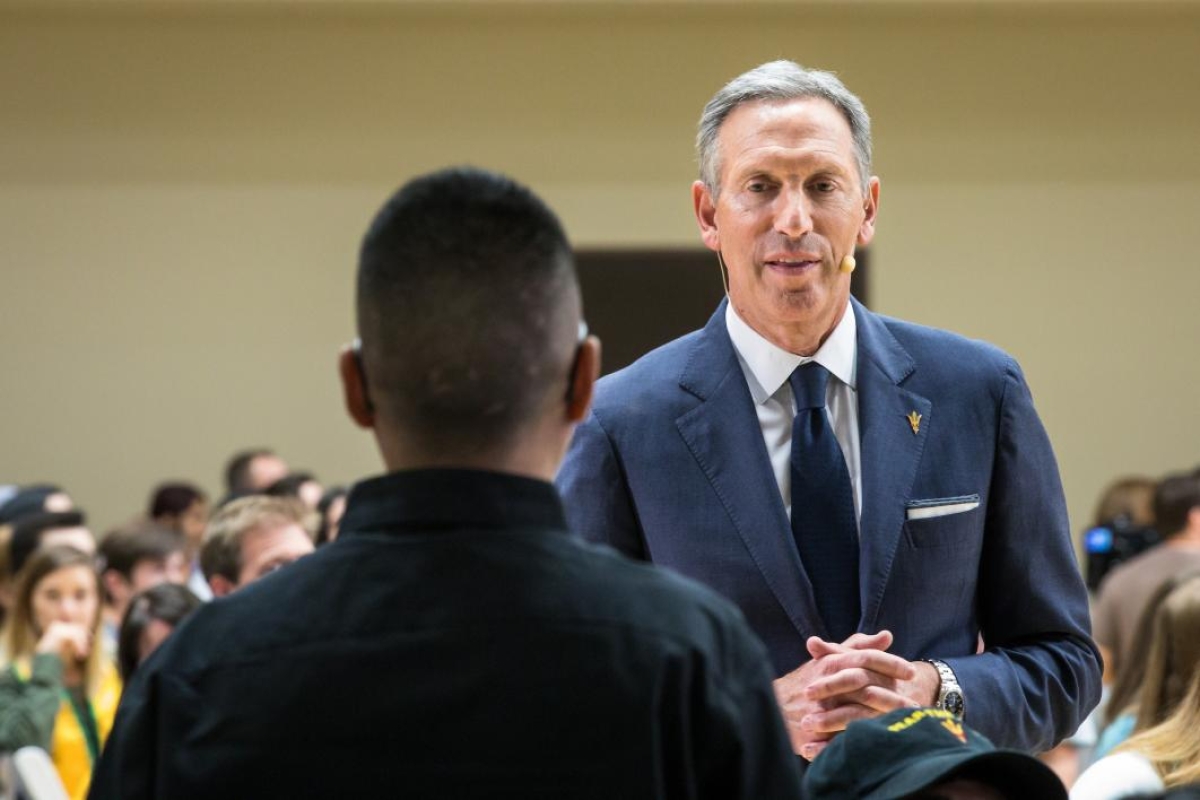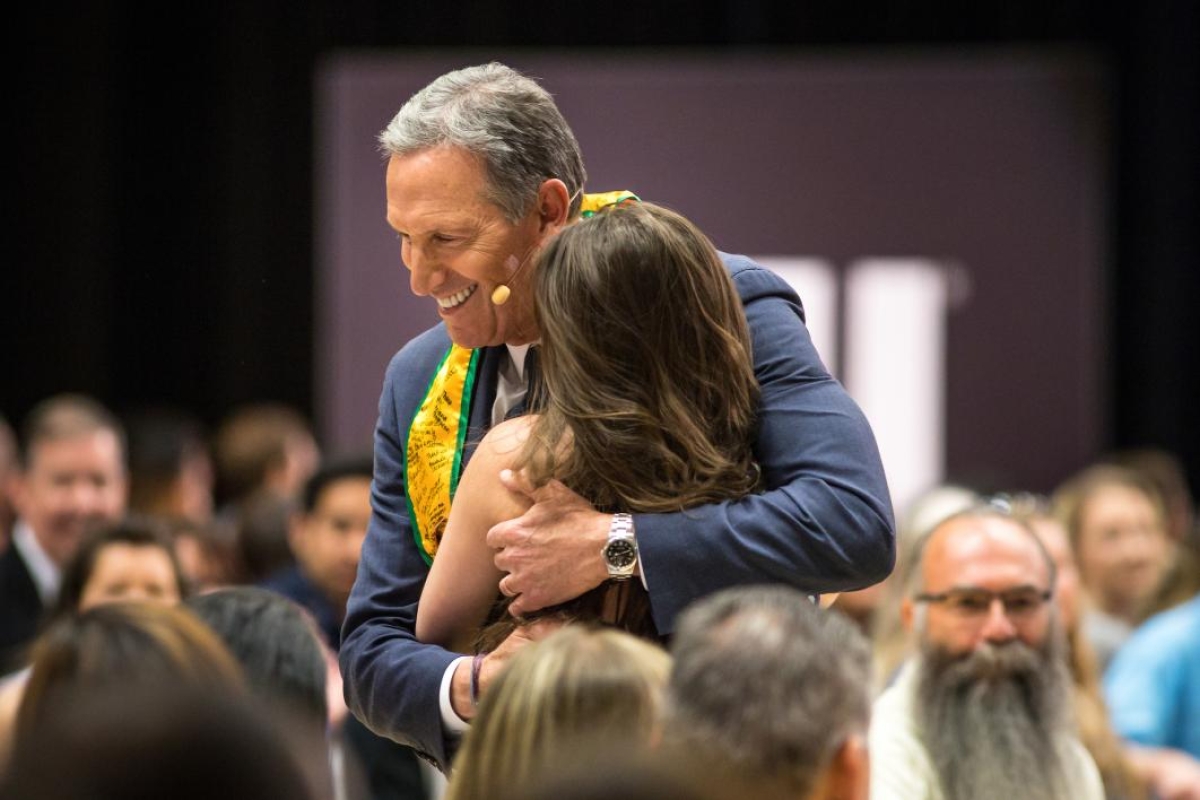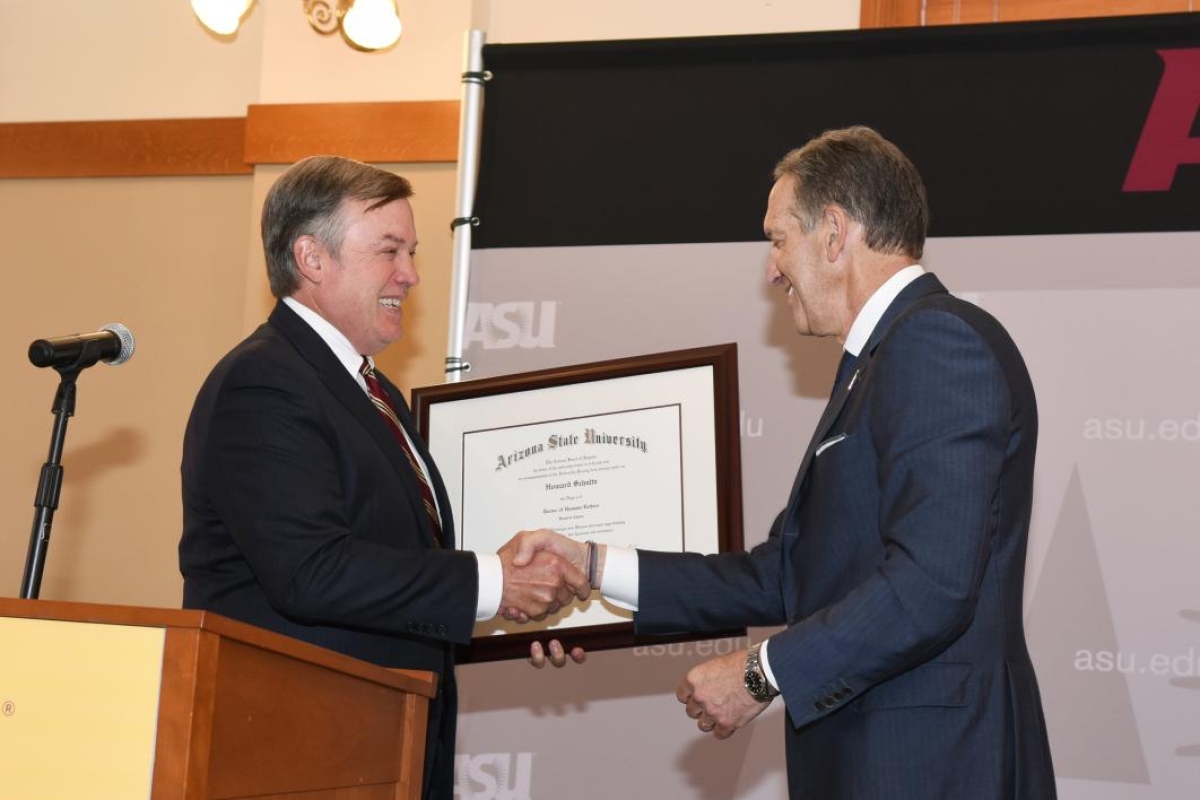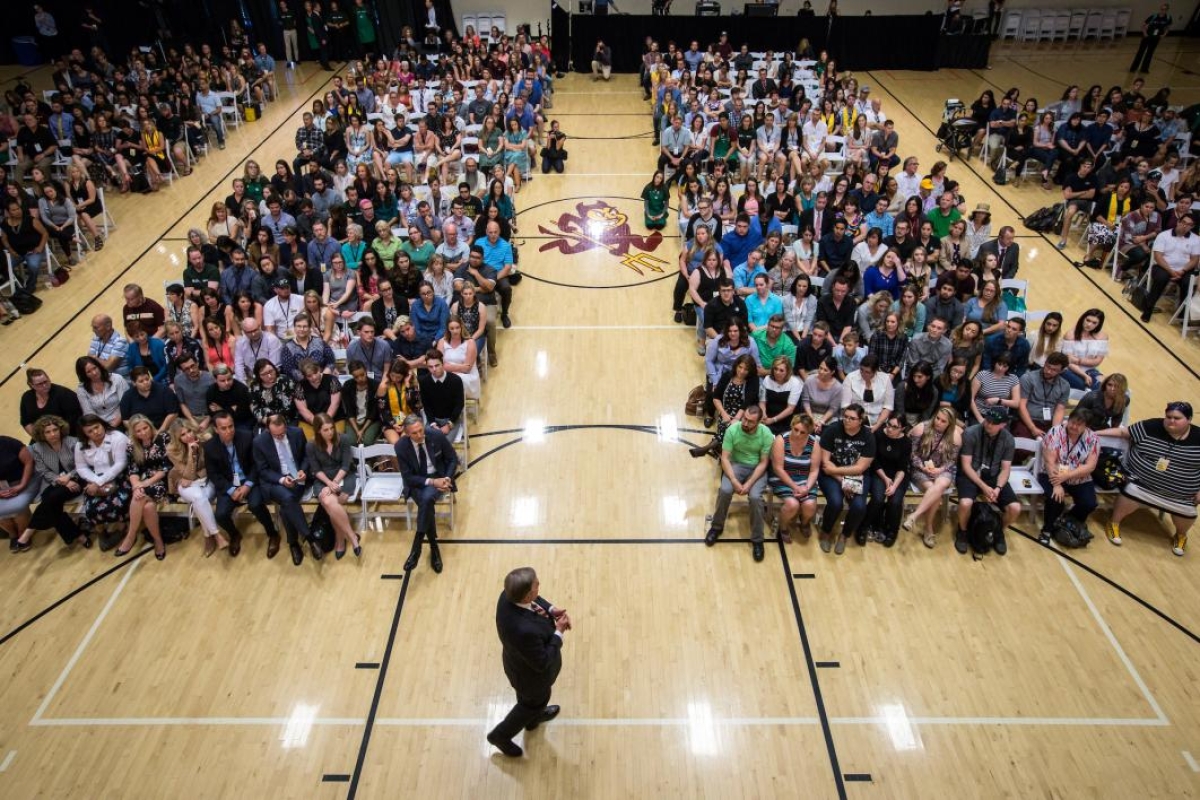Editor's note: This story is being highlighted in ASU Now's year in review. To read more top stories from 2017, click here.
After years of intense study and hard academic work, the newly minted college graduates of Arizona State University’s Class of 2017 are enjoying the well-deserved kudos of family and friends for all that they accomplished as undergraduates.
But at the Monday evening Undergraduate Commencement exercises in Sun Devil Stadium, they were also encouraged to go beyond what they learned in the classroom in order to create the future that they want and deserve.
“Summon your compassion, your curiosity, your empathy towards others and your commitment to service,” Starbucks Executive Chairman Howard Schultz told the graduating class. “Give more than you receive, and I promise you it will come back to you in ways you can’t possibly imagine.”
Schultz, the former CEO of Starbucks and the partner with ASU President Michael M. Crow in the creation of the Starbucks College Achievement Plan, delivered the commencement address at ASU’s May 8 ceremony and received an honorary doctor of humane letters degree from the university.
He encouraged graduates to be mindful of how they will, throughout their lives, respect and honor their families, share their successes and serve others with dignity, and lead with humility and demonstrate moral courage.
And he said that the graduates are ready to change the world.
“You’re leaving this campus as the best-prepared generation in the history of our country,” Schultz said.
A personal journey to a new kind of business
Throughout his remarks, Schultz shared personal details of growing up poor in Brooklyn with a father who had to work a series of “terrible blue-collar jobs,” and talked of his success as the CEO of Starbucks and his opportunity to build the kind of company his father never got to work at.
Starbucks has been at the forefront of providing employee benefits such as health insurance and an ownership stake to its employees.
Most recently, Starbucks has focused on providing an education as well.
In 2014, ASU and Starbucks collaborated on a first-of-its-kind program designed to allow the coffee giant’s employees, whom it calls partners, to earn a bachelor’s degree, with full tuition reimbursement through ASU’s digital immersion courses. More than 7,172 partners are now participating in the Starbucks College Achievement Plan.
Schultz congratulated the 330 Starbucks partners who graduated on Monday, but his speech was aimed at all graduates.
“Your generation can bring people together like no other,” he said. “You can innovate, create and lead.”
Change the status quo
In his address to the Class of 2017, Crow reminded graduates that their time at ASU was not designed to merely train them for a job.
“We’re training you, enabling you to be able to learn anything so that you can do almost any job,” Crow said. “So that you can accomplish almost anything. … A bachelor's degree to me means that you have found a way to begin the process of the mastery of learning itself.”
And he encouraged graduates not to accept the status quo no matter what field they enter, be it art or science, engineering, business or philosophy.
“Begin today to understand that it is the status quo itself which holds us back from attaining all of the things that we dream about as a society,” he said. “We cannot sit back and accept the way things have always been. Because we always must be advancing them towards these higher goals.”
“Do not accept the status quo; change the status quo.”
Earlier Monday, ASU hosted a luncheon in Schultz’s honor. After being presented with his honorary degree, Schultz described the work between his company and the university as doing exactly what Crow called for.
“The ASU-Starbucks partnership is a beacon of hope, not only to the students who have benefited from it, and our company’s culture and pride in what we have done, but it’s a demonstration that you can disavow the status quo,” Schultz said. “You can reinvent it. And you can be the kind of leader serving people that demonstrates that we are at our best when we do everything we can to lift people up.”
He also praised Crow, describing him as a “force.”
“You probably all know that,” he said to laughter. “He is a force for good, and the Starbucks coffee company has benefited from his partnership, and I have personally benefited from the enduring friendship that I have built with Michael Crow.”
After the luncheon, Schultz and Crow hosted an open forum for the graduating Starbucks partners. Partners from all kinds of backgrounds — single parents, military personnel, first-generation college students, Iraqi refugees — shared their personal stories of achievement.
Health sciences major Susana Mojica said she signed up for the Starbucks College Achievement Plan the same day she learned of it. The daughter of Mexican immigrants had always wanted to go to college but had to drop out after one year at Syracuse because of the cost. Because of the Starbucks College Achievement Plan, she now has a four-year degree and will be starting a master’s program in the fall.
“I know that a degree is not a waste of money,” Mojica said.
Many who spoke were overcome with emotion, embracing Schultz and thanking him for what the program has made possible. Schultz responded by reminding them that the “unorthodox partnership” wouldn’t have been possible without “the unbelievable innovation of ASU and its president, Michael Crow.”
Both Schultz and Crow referred to America’s broken education system, where mounting student-loan debt and lack of access are signs that there needs to be a disruption of the status quo.
“We can bemoan it, we can criticize it all we want,” Crow said. “But we need to do something about it. ASU and Starbucks, we have, we are and we will do something about all of this. And you all are benefactors of that.”
Even more stand to benefit from the program. Starbucks and ASU announced in March an expanded Pathway to Admission, which gives academically ineligible partners another opportunity to seek admission to ASU by successfully completing a series of courses offered through Global Freshman Academy.
A reason for hope
At Monday’s ceremony, Schultz alluded to the political situation in the country, saying that many of the graduates may be questioning the strength of the American Dream.
“Today you may question that dream and the promise of America,” he said to graduates. “And that’s fair. My generation has not made it easy for you. Our political leaders on both sides of the aisle have not acted with enough courage nor honesty in addressing the long-term challenges we face.”
But, he said, he has reason for hope.
“Despite all that, when I look to the future, I am extremely optimistic, especially when I look out and see you.”
Top photo: Starbucks Executive Chairman Howard Schultz speaks at ASU Undergraduate Commencement on Monday evening at Sun Devil Stadium in Tempe. Photo by Deanna Dent/ASU Now
More Sun Devil community

School of Transborder Studies celebrates 15th anniversary
During the summer before his freshman year at Arizona State University, Salvador Macias participated in the AGUILA Youth Leadership Institute, a college access organization designed to help young…

Barrett program unlocks study abroad for first-year honors students
Twenty first-year students from Barrett, The Honors College at Arizona State University are spending their second semester studying abroad in Rome, Italy.Traveling in a tight-knit honors community…

A champion's gift: Donation from former Sun Devil helps renovate softball stadium
Jackie Vasquez-Lapan can hear the words today as clearly as she did 17 years ago.In 2008, Vasquez-Lapan was an outfielder on Arizona State University’s national championship-winning softball team,…


